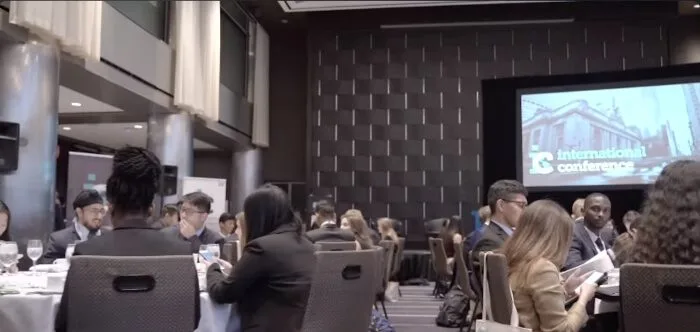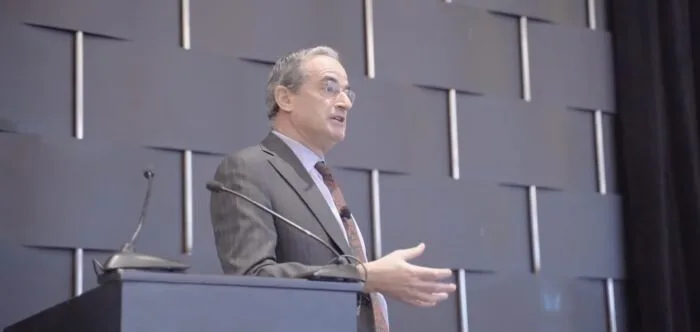Organizing a successful conference is no small feat. It is a journey that blends precise planning, coordination, and vision. When tackling the vital question is how long does it take to organize a conference.
Typically, the timeframe ranges from six months to a year, influenced by several key factors. These include the complexities of venue booking, lining up speakers, executing targeted marketing strategies, and managing attendee registration. Each element plays a crucial role in shaping the timeline.
To ensure a smoothly run event, early and efficient planning is essential. Dive deeper into our comprehensive blog, where we figure out the complexities of organizing a memorable conference, ensuring every detail is managed with precision and care.
What’s the Core Purpose of the Conference?
A conference serves as a melting pot of ideas, where experts and enthusiasts alike converge to share knowledge and insights. It’s an arena for networking, where professionals connect, promote collaborations that transcend beyond the event. This gathering is a catalyst for innovation, sparking discussions that lead to groundbreaking developments.

Central to its purpose, a conference offers a platform for learning and professional development. Attendees gain exposure to the latest trends, tools, and techniques in their area of expertise at events such as Canadian cyber security conferences. It’s an educational journey, enriching minds with fresh perspectives and up-to-date industry knowledge.
Beyond education and networking, conferences play a key role in shaping industry standards and practices. They provide a forum for debate, where new policies and strategies are forged. This aspect solidifies the conference’s status as a cornerstone for industry evolution and advancement.
How Long Does it Take to Organize a Conference?
Organizing a conference is similar to crafting a masterpiece, requiring time, dedication, and a keen eye for detail. The timeline often stretches from six months to a year, influenced by various factors that dictate the scale and success of the event. Let’s explore the essential components that shape this organizational journey.

Venue Selection
Choosing the right venue is pivotal, in setting the tone for the entire event. It’s about finding a balance between accessibility, capacity, and ambiance. Early booking is crucial to secure the ideal spot, often requiring months of planning. The venue’s availability can significantly impact the event’s scheduling.
Speaker Coordination
Securing speakers is a delicate process of negotiation and scheduling. It involves identifying relevant experts, extending invitations, and confirming their participation. This step is vital for establishing the conference’s credibility and appeal. Timing is key, as high-profile speakers often have packed schedules.
Marketing and Promotion
Effective marketing is essential to attract attendees and build buzz. This involves creating a compelling narrative around the conference’s theme and goals. Strategies include digital campaigns, social media outreach, and partnerships. Consistent, engaging promotion can span several months leading up to the event.
Attendee Registration
Managing registration is a complex task, ensuring a smooth process for attendees. This involves setting up registration platforms, tracking sign-ups, and handling inquiries. Early bird promotions can stimulate early interest and commitment. Efficient registration systems contribute to a positive attendee experience.
Program Development
Making a cohesive, engaging program is the heart of conference planning. It requires balancing keynote speeches, workshops, and networking sessions. Feedback from past events can inform program improvements. This stage is iterative, often undergoing several revisions.
Logistical Coordination
At last, logistics are the backbone of a successful conference. This encompasses catering, audio-visual equipment, transportation, and accommodations. Attention to detail is paramount to avoid last-minute hiccups. Effective logistics ensure a seamless experience for both attendees and speakers.
Each of these factors plays a critical role in the timeline and quality of a conference, weaving together to create an event that’s educational, engaging, and memorable.
Requirements to Organize a Conference
The process of organizing a conference goes beyond booking a hall and inviting guests. Each detail needs careful consideration to ensure attendees enjoy a memorable and enriching experience. To plan a successful conference, here are some key requirements.
Choosing the Perfect Venue
Selecting the right venue forms the backbone of any successful conference, directly impacting attendee satisfaction and the overall event atmosphere. Considerations include assessing location convenience, available parking facilities, and adequate seating capacity, matching perfectly with the conference’s overall goals. For example it is common for the organizers of conferences in Canada to choose venues in major cities like Toronto or Vancouver for their accessibility. Location plays an important role in enhancing participants’ comfort, supporting smooth event operations, and boosting attendance.
Curating Expert Speakers
Securing experienced, knowledgeable speakers is fundamental to creating compelling content that keeps attendees engaged throughout the entire duration of conferences. Speakers must possess strong subject-matter expertise, effective communication skills, and credibility within their specific fields to captivate their audience. Diversifying your speaker lineup with both established industry leaders and emerging professionals ensures fresh perspectives and valuable insights for participants. Thoughtfully chosen speakers not only deliver meaningful presentations but also contribute substantially toward increasing attendance and the overall prestige of your event.
Effective Marketing Approach
An impactful promotional strategy generates anticipation and encourages potential attendees to register, significantly boosting the reach and success of the conference. Successful marketing involves utilizing digital platforms like social media, email newsletters, event websites, and traditional advertising methods to attract participants. Engaging promotional content, clear communication, and timely updates help maintain interest and build momentum leading up to the event day. Thoughtful marketing not only attracts attention but also sets expectations, making attendees excited about the valuable experiences awaiting them.
Efficient Registration System
Creating a seamless, user-friendly registration process enhances attendee satisfaction by providing convenience, ease of use, and clear communication at every step. A reliable online registration platform should quickly process sign-ups, securely handle payment transactions, and instantly confirm attendees’ participation via personalized emails. Moreover, offering flexible registration options such as early-bird discounts, group rates, and clearly defined cancellation policies helps attract a broader audience. Streamlined registration ensures guests have positive initial impressions, contributing significantly toward overall satisfaction and encouraging future participation.
Structuring the Conference Program
Carefully designing a balanced event schedule allows attendees to gain maximum value by participating in informative sessions, discussions, and networking opportunities. Program planning should thoughtfully combine engaging keynote presentations, interactive panel discussions, breakout sessions, and adequate breaks to keep attendees energized. Considering participant interests, industry trends, and session diversity ensures meaningful interactions while maintaining continuous attendee engagement throughout the event duration. A thoughtfully constructed agenda not only enriches attendee experiences but also creates memorable impressions that encourage continued participation in future conferences.
Managing Event Logistics
Efficiently managing logistical details like catering, audiovisual setups, transportation, and room arrangements ensures the conference proceeds without unexpected disruptions or complications. Attention to details, including appropriate technology setups for presentations and smooth coordination with vendors, significantly impacts attendees’ perceptions of professionalism. Ensuring timely meal services, adequate refreshment stations, comfortable seating, and functional amenities guarantees participant satisfaction from start to finish. Effective logistical management ultimately translates into seamless event execution, positively reflecting on your organizational skills and enhancing attendee trust.
How to Organize a Conference?
Organizing a conference is a journey of bringing together ideas, people, and experiences. It’s a task that requires precision, foresight, and a deep understanding of your audience’s needs. This step-by-step guide will provide you with a roadmap to manage the tricky process of creating a successful conference.
Step 1: Identify the Conference Objectives and Audience
Start your conference planning by setting clear objectives. Consider the key messages or themes that are central to the event. It’s essential to have a deep understanding of your target audience, as this will shape everything from the content to the style of the conference. This initial step is critical in determining the overall direction and tone, ensuring that the event resonates with its intended participants.
Step 2: Budget Planning and Fundraising
Careful budgeting is essential to the success of your conference. Account for all potential costs, including venue, speakers, marketing, and technology. Explore various funding options such as sponsorships, grants, or ticket sales. A solid financial plan ensures you have the resources needed to execute your vision.
Step 3: Venue Selection and Date Setting
Selecting the right venue is a critical decision. It should not only accommodate your expected number of attendees but also resonate with the conference’s theme. Accessibility and technical capabilities are key considerations. Additionally, choose a date that is convenient for your target audience and avoids major conflicts with other industry events.
Step 4: Develop the Program and Secure Speakers
Creating a dynamic and engaging program is at the heart of your conference planning. This includes a mix of well-organized keynote speeches, panels, workshops, and networking sessions. Reach out to speakers who are not only experts in their field but also engaging and relevant to your audience. A well-curated program is a major draw for attendees.
Step 5: Marketing and Promotion
Develop a comprehensive marketing strategy to promote your conference. Utilize various channels like social media, email marketing, and partnerships with industry organizations. Tailor your message to resonate with your target audience, highlighting the unique value and experiences your conference offers.
Step 6: Registration and Logistics Management
An efficient registration process is key to a positive attendee experience. Use a reliable conference registration platform that is easy to manage. In terms of logistics, pay attention to details like signage, audio-visual equipment, catering, and transportation. Ensuring these elements are well-coordinated will contribute to a smooth and professional conference experience.
Arranging a conference is a complex but rewarding endeavor. Each step, from defining your objectives to managing the day-of logistics, is crucial in crafting an event that resonates with your audience. With careful planning and a keen focus on detail, you can create an impactful and memorable conference that exceeds expectations.
Challenges to Overcome While Organizing a Conference
Organizing a conference is a complicated task that requires juggling multiple elements at the same time. Each phase of planning presents its unique set of challenges. To help you overcome these obstacles the key is to host a successful event.
- Securing Funding: Obtaining adequate funding is crucial and often challenging. It involves identifying sponsors and managing budget constraints effectively.
- Choosing the Right Venue: The venue must not only fit your budget but also accommodate your attendees comfortably. Location accessibility and available facilities are major considerations.
- Speaker Acquisition: Securing the right speakers can be a daunting task. It involves negotiating terms and aligning schedules, which can be complex.
- Marketing and Promotion: Crafting an effective marketing strategy is essential for attracting attendees. It requires balancing digital and traditional marketing methods efficiently.
- Technology Management: Ensuring reliable technology for presentations and communications is crucial. Technical glitches can significantly disrupt the conference experience.
- Participant Engagement: Keeping attendees engaged throughout the event is challenging. It requires a dynamic program and interactive sessions.
- Logistical Coordination: Managing logistics, from catering to accommodation, requires meticulous planning. Any oversight can impact the overall event quality.
While organizing a conference is demanding, overcoming these challenges can lead to a rewarding and impactful event. It’s about creating a memorable experience that resonates with both speakers and attendees.
Conclusion
In event planning, organizing a conference is a complex task that blends strategic foresight with precise execution. Each decision, from venue choice to program development, contributes to the event’s overall success.
Addressing how long does it take to organize a conference reveals that it’s a journey of six months to a year, filled with careful planning and coordination. This duration is crucial for aligning all elements, from securing speakers to marketing the event effectively.
In essence, the effort put into organizing a conference is reflected in its impact and attendee satisfaction. It’s a process that not only demands time but also a deep commitment to creating an enriching and memorable experience for everyone involved.






